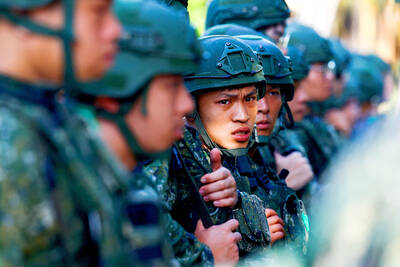Luk Kreung means mixed-blood in Thai, and refers both to mixed ethnicity of restaurant owner Tseng Hsu-min (曾旭民), as well as the mixed parentage of the cuisine that he presents — an innovative combination of Italian and Thai.
When living in Thailand, Tseng, 36, said he frequented a restaurant that cooked Italian food in a Thai style. He believed that this combination would prove popular in Taiwan as well, so two years ago he opened Luk Kreung in Taipei's trendy East District.
On its Chinese-English menu, there is an image of the Virgin Mary, representing Italian food, and one of the Buddha, representing Thai food. These are combined to create his “mixed blood” cuisine.

PHOTO: GINGER YANG, TAIPEI TIMES
This leads to some interesting combinations. There is da-pao pork, a dish of thinly sliced boiled pork with various garnishes, which is a regular feature at many Indo-Chinese themed restaurants. But in this case, it is served on a cornmeal pizza crust (NT$250), with the addition of minced meat and basil. Restaurant manager, Lai Chien-an (賴建安) said it was especially popular as a take out order.
Italian-style fried rice noodles (NT$220) uses anchovies to enhance the flavor of the traditional Thai dish, and can be fine tuned to individual tastes with sugar, ground peanuts and lemon, which are served on the side of the plate. The deep fried trout with Thai apple dressing (NT$480) and grilled beef tenderloin in green curry sauce (NT$700) are worth trying.
Luk Kreung mixes it up with the decor as well; half decorated in palatial Italian style and the other half featuring Thai-themed furniture. The furnishings are uniformly both comfortable and stylish. In fact, the establishment could easily be mistaken for a high-class furniture shop if you don't look too carefully.
There are two rooms for private functions that seat up to 12 people.
The setting is much more luxurious than you would expect for the menu's price range. “We spent more than six months designing the menu and settings. We let our imaginations run wild. Running this restaurant isn't work, it's play,” Lai said. Service is stylish, but not particularly efficient.
After the kitchen closes, Luk Kreung transforms itself into a lounge bar that serves a wide range of spirits and wine. If you want to reserve a seat, call after 5 pm.

Many people noticed the flood of pro-China propaganda across a number of venues in recent weeks that looks like a coordinated assault on US Taiwan policy. It does look like an effort intended to influence the US before the meeting between US President Donald Trump and Chinese dictator Xi Jinping (習近平) over the weekend. Jennifer Kavanagh’s piece in the New York Times in September appears to be the opening strike of the current campaign. She followed up last week in the Lowy Interpreter, blaming the US for causing the PRC to escalate in the Philippines and Taiwan, saying that as

Nov. 3 to Nov. 9 In 1925, 18-year-old Huang Chin-chuan (黃金川) penned the following words: “When will the day of women’s equal rights arrive, so that my talents won’t drift away in the eastern stream?” These were the closing lines to her poem “Female Student” (女學生), which expressed her unwillingness to be confined to traditional female roles and her desire to study and explore the world. Born to a wealthy family on Nov. 5, 1907, Huang was able to study in Japan — a rare privilege for women in her time — and even made a name for herself in the

Would you eat lab-grown chocolate? I requested a sample from California Cultured, a Sacramento-based company. Its chocolate, not yet commercially available, is made with techniques that have previously been used to synthesize other bioactive products like certain plant-derived pharmaceuticals for commercial sale. A few days later, it arrives. The morsel, barely bigger than a coffee bean, is supposed to be the flavor equivalent of a 70 percent to 80 percent dark chocolate. I tear open its sealed packet and a chocolatey aroma escapes — so far, so good. I pop it in my mouth. Slightly waxy and distinctly bitter, it boasts those bright,

“Taiwanese increasingly reluctant to give their lives to defend the island,” trumpeted a South China Morning Post (SCMP) headline last week. The survey asked whether people should be prepared to pay any price — including death — to protect Taiwan and prevent “reunification.” “The poll found that 52.2 percent of those questioned were unwilling to do so — an 8.4-point rise compared with a similar survey carried out two years ago — while 40.8 percent were willing, down four points on the previous survey,” the article said. Treated as anti-Taiwan propaganda, the piece was sent around by the usual pro-China suspects